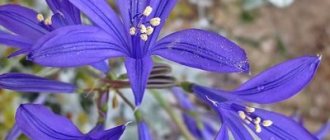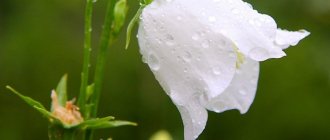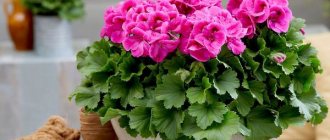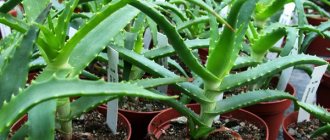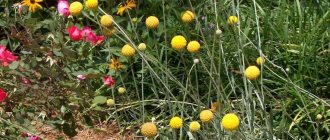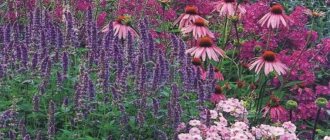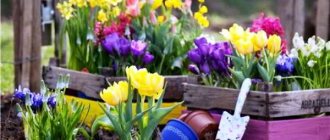Photo: wallpaperscraft.com Lilies are fabulously beautiful and absolutely recognizable, but such popularity has a downside. It happens that we see a lily, and do not even realize that in fact it is a completely different plant from a different family. And sometimes you want to plant lilies in the garden or at home, but the conditions are not suitable. To prevent this from happening again, we have prepared a selection of 17 similar colors. Take a look and get acquainted!
Narcissus
Although daffodils are very recognizable, inexperienced gardeners can easily confuse them with lilies due to the characteristic shape of the flowers. There are dozens of types of daffodils in different shades.
Photo: oir.mobi
Flowers similar to roses: names and photos (catalog)
This is a capricious flower: truth or myth
The oriental lily is often considered capricious. This opinion was formed for the reason that it does not tolerate wintering well when planted in the middle climate zone.
But breeders have been able to create new varieties of flowers that bloom early and are characterized by resistance to weather conditions.
Lily Fabienne is so beautiful that you can forgive her all the whims in her care.
Some types of lilies bloom only 2-3 years after planting. This is due to the too large size of the flowers, which often have an atypical number of petals.
Requirements for growing a plant
Of course, planting and caring for oriental lilies is somewhat difficult. However, there are no special, atypical requirements for breeding them.
Flowers feel comfortable both in the sun and in slight darkness. The plant does not like excessive humidity.
Hyacinth
Although hyacinths have a completely different shape of inflorescences and small flowers are collected in large clusters, individually they really resemble lilies. The plant is famous for its richness of colorful varieties and delicate aroma.
Photo: sady-msk.ru
Flowers that look like bells: names and photos
Unrelated flowers similar to lilies - order Asparagusaceae
Of course, there are flowers in the world that look like lilies, not from the Liliaceae order, and we have prepared for you some plants with photos and names.
We have chosen families, among which there are beautiful and unusual flowers.
Hesperocalisaceae . Hesperocallis is a lily-like flower on a thick stem.
Hesperocallis - a desert inhabitant with a beautiful flower
.
Ixiolirionaceae
Ixiolirion Tatarian - amazing beauty!
.
Among the Irisaceae , in addition to the familiar iris (“cockerel”), Watsonia can be distinguished.
Watsonia
.
Xanthorrhoeae family deserves special attention thanks to the genus Daylily. Various types of daylilies are very popular among our gardeners and are highly decorative.
At the moment, there are a great many varieties of daylilies with flowers of different colors.
Yellow daylily (Hemerocállis lílioasphodélus) also known as yellow lily or red lily
.
Among the Prolesaceae , hyacinths are very similar to lilies.
Especially for lovers of lilies with small flowers, we recommend growing oriental hyacinth. Flowers similar to small lilies are not difficult to care for and grow.
- Oriental hyacinth is highly decorative with a strong and at the same time pleasant aroma.
Hyacinth is suitable for growing in winter and cutting for bouquets, and is also one of the most popular house flowers.
There are more than 300 varieties of hyacinth with different colors: white (Inosans), pink (Pint Pearl), blue (Miosotis) and red (Jean Beauce). Hyacinth blooms for about 12-16 days.
This flower is similar to small lilies, usually 15-25 cm in height with shiny and succulent leaves. The flowers themselves are bell-shaped in cylindrical inflorescences.
Black hyacinth
.
Amaryllis family: champion among lily-like flowers
The amaryllis family includes more than 60 genera, of which there are a large number of flowers resembling lilies.
AMARILLIS AND HIPPEASTRUM
We have separated these two genera, as flower growers often confuse them. Amaryllis and hippeastrum are similar in appearance, have large bulbs and thick peduncles with “umbrellas”.
According to the official classification, the Amaryllis genus includes one species - Amaryllis belladonna. Amaryllis belladonna is a rather rare plant and is not widely distributed among domestic flower growers.
Much more often you can find hippeastrum, which some sellers knowingly or unknowingly sell under the guise of “amaryllis”. Hippeastrum is well suited for growing as a potted crop and for cutting.
Amaryllis
It's not for nothing that belladonna is actually called the belladonna lily, because they are remarkably similar. This is a moisture-loving large plant, the buds of which open up to 12 cm in diameter.
Photo: goodfon.ru
Types and varieties of daylily: photos, names and descriptions
Caring for asparagus at home
Illumination
To grow asparagus, choose a windowsill with an eastern or western orientation. The fact is that it needs bright sunlight, but the scorching direct rays of the sun should not fall on it. However, the rays of the morning or evening sun will not harm the plant. If a place for asparagus was found only in the southern room, then it should be placed away from the window. With the onset of May, you can begin to accustom the bush to fresh air, but this must be done gradually. And in the summer, it can be moved to the garden or to the balcony, but you need to choose a place for it that will be protected from precipitation, the scorching rays of the midday sun and drafts.
Temperature
Make sure that in the summer the asparagus is not exposed to heat for a long time (more than 25 degrees). The optimal temperature for it in spring and summer is from 22 to 24 degrees. If during the winter months the bush is in a room that is too warm (more than 15 degrees), then its leaves will begin to fly away, even if the air humidity is high. Dried shoots must be cut off.
Watering
During active growth, indoor asparagus is provided with abundant regular watering. The soil mixture in the pot is moistened immediately after its top layer dries. In the autumn-winter period, watering is carried out only a couple of days after the top layer of the substrate in the pot has dried. Make sure that there is no drying out of the lump of earth in the pot or stagnation of liquid in it. It is recommended to water asparagus through a tray. To do this, pour the required amount of water into the pan, and after 30 minutes. from it they pour out what the earth mixture did not absorb.
Air humidity
When growing asparagus indoors, it is recommended to systematically moisten it with a sprayer, especially if the room is too hot. The best time to moisten the bush is early morning or evening (shortly before sunset). You can increase air humidity by pouring moistened sphagnum or expanded clay into a tray and placing a container with a plant on it, while moistening from a spray bottle is also carried out regularly.
Bloom
In order for asparagus grown indoors to bloom, you need to try hard. But if it begins to bloom, then inflorescences consisting of small white flowers will grow on the tops of its stems. If desired, carry out artificial pollination; to do this, take pollen from one flower with a soft brush and carefully move it to another. The fruit is a berry that is colored deep red.
Trimming
Asparagus is pruned in early spring when the bush is replanted. To do this, cut off all leafless stems that are already very old, thanks to this the growth of young shoots improves.
Fertilizer
This plant should be fed all year round. In winter, fertilizing is carried out once every 4 weeks, in the autumn months - once every half month, and in the spring-summer period, the frequency of fertilizing is increased to once every 7 days. For this purpose, mineral complex fertilizers are used, and they can be alternated with organic matter. The finished nutrient mixture should be of very low concentration.
Transplanting asparagus
A young bush, before it turns 4 or 5 years old, is transplanted once a year in the spring. An older plant needs to be replanted less frequently, namely, once every 2 or 3 years. It is necessary to replant asparagus so often because its root system is characterized by very rapid growth. In this regard, when replanting, it is necessary to take a pot that is slightly larger than the old one, and the roots should be slightly trimmed.
Be sure to add a good layer of drainage to the bottom of the pot using expanded clay, this will prevent liquid from stagnating in the substrate. A suitable soil mixture should consist of humus and leaf soil, as well as sand (2:2:1). If desired, you can also add 2 parts of turf soil to this soil mixture. The transplanted bush is well watered, and after 7 days the first feeding is carried out.
Asparagus. Transfer.
Watch this video on YouTube
Virulence
If asparagus flowers are manually pollinated during flowering, then red berries that contain poison can be formed. They should not be eaten under any circumstances.
Those who have pets or children should pay special attention to this.
Trimming
If the plant is not pruned, then from 80 to 130 buds may appear on it, although they will be very small. In the spring, after the first shoots appear, the plant requires thinning - only the strongest branches are left, cutting off about a third of the shoots. Subsequently, withered leaves and wilted flowers are removed, and old stems are also cut off, leaving about 10-15 cm of shoots from the root. This pruning not only improves the appearance of alstroemeria, but also prevents possible diseases.
Alstroemeria is very valuable for cutting, and when cut it can stand for up to a month.
Advice!
The stems of a young plant are very fragile, so to prevent them from breaking in the rain or wind, they will need to be supported.
Alstroemeria ligtu. One of the most cold-resistant species, native to Chile
Alstroemeria propagation
Alstroemeria can be propagated either by seeds or by dividing rhizomes. When growing a flower from seeds, flowering will occur only in the third year. Alstroemeria seeds are planted for seedlings in February-March, preparing the soil composition from 1 part turf and 2 parts leaf soil. The seeds are sown on the ground and, after slightly pressing, are literally sprinkled with soil. The container with the seeds is placed in a plastic bag and sent for stratification, which is carried out at a temperature of 2-5°C for a month, after which the container is transferred to a warm place - about 20°C. Exposure to low temperatures leads to seedlings appearing in 10-20 days (but some seeds may germinate much later). Seedlings are planted in the ground at the end of May-beginning of June, when the threat of night frosts has completely disappeared.
Alstroemeria is naturally pollinated by bees, as well as hummingbirds. But in their absence, wind pollination is also possible
Dwarf alstroemeria is found in Argentina and Chile (including the Andes) on pebbles of lake shores. Plant height - up to 8 cm
It is preferable to propagate alstroemeria by dividing the rhizomes - if planted in the fall, you can get flowering in the spring. The rhizomes of adult (about 3 years old) plants are divided, and at least 5 buds should remain on each division. In addition, this helps to rejuvenate plants and streamline their growth; for example, parrot alstroemeria grows very quickly and can literally “squeeze out” its neighbors in a few years. Before planting, a small amount of organic fertilizer is added to the hole; after planting, the soil is mulched.
Cut alstroemerias readily open buds in water and will decorate your home for 2 weeks to a month.
How to choose
The number of varieties of ornamental plants in stores and on the market is amazing, however, in order not to be disappointed after purchasing a bulb for planting, you should pay attention not only to the colorful photo of the flower. First, it is advised to choose a group of plants, instead of oriental and trumpet varieties for the garden; novice gardeners are better off buying unpretentious Asiatic lilies. In strong and healthy bulbs:
- scales fit tightly;
- no damage or rot;
- the bottom is dry and clean.
Flowers take root quickly and overwinter without problems when planted at the end of September. Bulbs with long shoots, placed in the soil in the spring, often bloom the following year.
Difference between Oriental and Asiatic lilies
Here are the differences:
- The eastern ones have a larger flower diameter - about 30 cm.
- More pronounced aroma.
- The predominant shades of the oriental flower are crimson, pink, yellow and white. Asians come in a variety of colors.
- The height of the bush of the Oriental variety is approximately 120 cm, while that of their counterparts is about 150 cm.
Oriental lily hybrids are more demanding in terms of care and growing conditions; they have less resistance to frost and are sensitive to fertilizers.
Wintering
Most alstroemeria varieties are very heat-loving (although hybrids have already been bred that can withstand frosts down to -25°C), so it must be covered for the winter. With the onset of autumn, they stop watering the plant, before the first frost the above-ground part is cut off, and the place itself is covered with spruce branches, dry leaves or straw, then everything is covered with plastic film, on which a layer of earth, straw or mulch is again poured. All this should protect the ground from freezing. The older the plant, the better it tolerates frost. In the southern regions, alstroemeria can overwinter in open ground.
Alstroemeria is a mountain plant, so it can safely tolerate short frosts - daily temperature changes. But in our winter conditions, it requires preparation for a full winter.
In our climatic conditions, it is better to dig up the tubers of the perennial alstroemeria and transfer them to wintering
